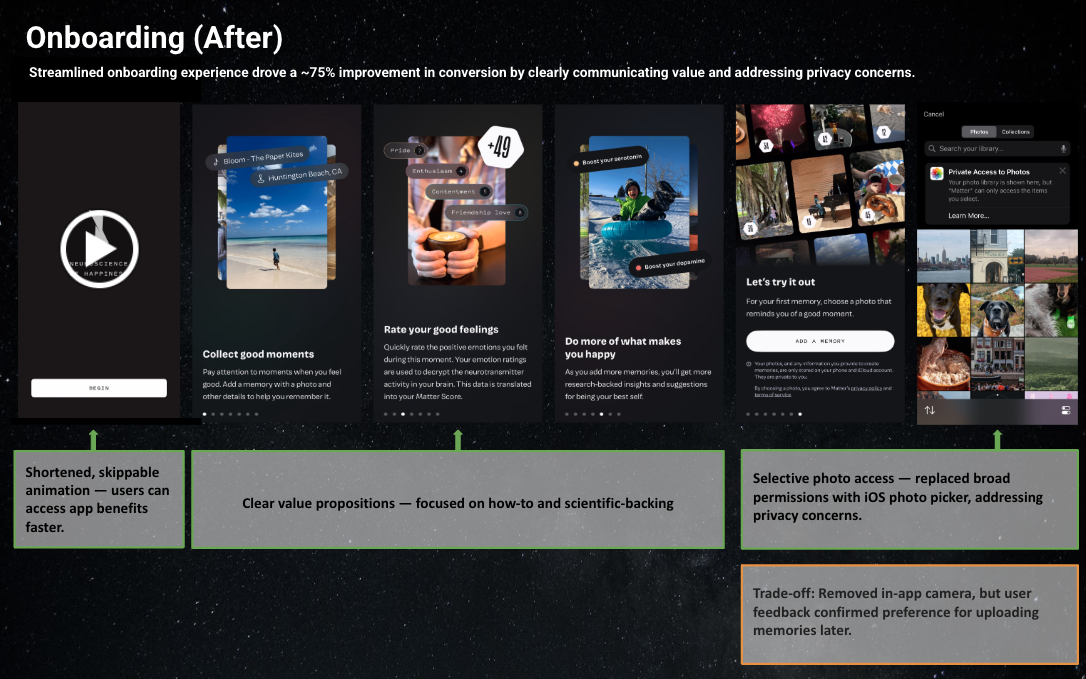Building a Seamless In-Car Voice Assistant System
Hardware Device, Mobile App, AI-powered Voice Assistants
Year
2023
Company
Native Voice AI
OVERVIEW
Role: Lead UX Researcher
Time Frame: 5 months
Methods: Beta Testing, User Interviews, In-App Feedback, Unmoderated User Tests, Analytics Tracking
Key Metrics: 10k Downloads, 4.7 App Store Rating, 2x increase in Onboarding Conversion, 210% increase in engagement
PROBLEM STATEMENT
Users in the mental health space often lack personalized, data-driven tools that help them consistently track progress and improve emotional well-being.
While users initially found the science behind Matter intriguing, our research revealed a key insight: scientific credibility alone wasn’t enough. The real challenge lay in translating these insights into daily habits that users would stick with.
This realization shaped our approach during the beta testing phase, where two primary challenges emerged:
Low Onboarding Conversion: Users did not upload their first memory during onboarding due to unclear value propositions.
Inconsistent Engagement: Although users appreciated the science, they lacked the motivation for continued use.
RESEARCH GOALS
RESEARCH GOALS
[Optional Image: Research roadmap or goal icons for visual interest]
With the target persona defined and the public beta underway, our next step was to uncover why users weren’t engaging as expected. Our research aimed to bridge the gap between user curiosity about the science and the formation of daily mental health habits.
The research was driven by four primary goals:
Identify the Root Causes of Low Onboarding Conversion
Determine why users were dropping off early, particularly during the first memory upload, and how to improve initial engagement.
Understand User Motivations and Barriers
Explore what drives sustained engagement and habit formation in a mental health context, focusing on how users integrate the app into their daily routines.
Iteratively Refine Core Features
Ensure that updates and new features align with user needs, increasing the likelihood of long-term usage and habit formation.
Continuously Gather and Apply User Feedback
Maintain a robust feedback loop through in-app feedback, interviews, and usability testing to inform rapid iterations and address pain points promptly.
These goals informed a structured, multi-phase research plan designed to uncover actionable insights, validate hypotheses, and refine Matter into a habit-forming mental health tool.
RESEARCH METHODS
[Optional Image: Research methodology timeline or icons representing each research phase]
To refine Matter into a habit-forming mental health app, I led a comprehensive five-month research program. The approach integrated foundational, generative, and evaluative methods, capturing both qualitative and quantitative insights across the user journey.
🔍 Research Methodologies Employed
Public Beta Launch & In-App Feedback (Ongoing Throughout the Project)
[Optional Image: Screenshot of beta announcement or user testimonials from the beta phase]Duration: 5 months (ongoing from the start of the project).
Participants: 500 users recruited via LinkedIn, social media, and direct outreach.
Approach: Agile development with 3-week sprint cycles, incorporating iterative testing and feedback loops for rapid feature refinement.
In-App Feedback: Continuous feedback collection on new features, satisfaction levels, and pain points provided real-time insights that directly influenced sprint planning and prioritization.
Purpose: The integration of in-app feedback with the beta launch ensured a responsive development process, allowing rapid adjustments based on evolving user needs.
Analytics Tracking
Purpose: To establish a quantitative baseline by identifying key drop-off points in the user journey, focusing on onboarding conversion and engagement patterns.
User Interviews
Purpose: To gain deep qualitative insights into user perceptions, motivations, and barriers that the analytics data alone couldn’t reveal.
Moderated & Unmoderated Usability Testing
Purpose: To assess user interactions with updated and new features in both controlled (moderated) and real-world (unmoderated) environments, ensuring that design changes aligned with user expectations and improved usability.
Planned Diary Study (Not Conducted)
Purpose: Intended to uncover deeper insights into daily app integration, emotional triggers for memory uploads, and habit formation challenges.
Why It Wasn’t Conducted: Due to bandwidth constraints, we prioritized faster-turnaround methods. We compensated by leveraging in-app feedback and additional usability tests.
This research strategy provided a robust foundation for iterative product development. Insights from these methods are detailed in the subsequent sections, where each key feature’s evolution is paired with its corresponding research-driven decisions and impact.
KEY FINDINGS & IMPACT
Persona Evolution: A Key Insight
Through the research process, our understanding of the target persona evolved significantly. While the initial persona reflected users interested in neuroscience-backed mental health approaches and digital well-being tools, research revealed:
Less Exploratory, More Goal-Oriented: Users had less of an exploratory approach to neuroscience for well-being. Instead, they sought goal-tracking methodologies (e.g., daily ring features) that fostered regular habit-building.
Importance of Habit Formation: This shift was crucial because consistent daily engagement is essential for meaningful mental health outcomes. Users wanted tangible daily progress indicators, emphasizing structured engagement over exploratory learning.
This key insight directly influenced the prioritization of habit-forming features such as the Ring Goal, ensuring the app fostered regular usage patterns essential for improving mental health.
Key Differences from Initial Persona:
Shifted from exploration-focused to achievement-focused
Prioritizes habit formation over scientific understanding
Values structured daily goals over flexible exploration
Seeks tangible progress metrics rather than theoretical knowledge
Responds better to gamification elements than scientific content
Onboarding Experience & Activation
Research Methods: Analytics, User Interviews, Moderated Usability Testing
Key Insights: Users found the onboarding animation too long and unclear. Hesitation around granting broad photo permissions also hindered onboarding completion.
Impact:
Shortened, skippable animation focusing on value propositions.
Replaced broad photo access requests with selective photo uploads using the native iOS photo picker.
Result: Onboarding conversion increased to 62% (~110% improvement).
Notifications
Research Methods: User Interviews, In-App Feedback, Unmoderated Usability Testing
Key Insights:
The default evening reminder at 8 PM did not align with diverse user preferences.
Users felt the reminders were generic and uninspiring “eg. Time to upload a memory!”, lacking context or personal relevance to motivate action.
Users expressed a need for customizable reminder times to better fit their routines and lifestyles.
Impact:
⏰ Flexible Notification Times: Introduced custom reminder options, allowing users to choose between morning and evening notifications for better alignment with daily habits.
💡 Science-Backed Messaging: Enhanced notifications with neuroscience context and emotion-specific prompts, boosting perceived relevance.
📈 Improved Retention: Achieved 18% 30-day retention, reflecting sustained engagement driven by personalized reminder schedules and meaningful content.
Emotion Rating
Research Methods: Analytics, Interviews, Unmoderated Usability Testing
🔍 Key Insights:
The emotion rating screen was a clear drop off point as shown by analytics.
Users found the sliding scale for rating emotions confusing and time-consuming, especially without clear context.
It was cumbersome to click on the “i” icon for each emotion to reveal descriptions, disrupting the reflection flow.
Users desired a more intuitive, quick, and meaningful way to reflect on their daily emotions.
🚀 Impact:
🔄 Simplified Selection: Replaced the scale-based rating with a tap-to-select emotion system, significantly reducing friction during the reflection process.
💡 Contextual Understanding: Embedded brief explanations of each emotion and its neuroscience link, helping users better understand their emotional patterns.
⏱️ Faster Interactions: Reduced average rating time by X% (if you have data), boosting completion rates for daily reflections.
📈 Improved Engagement: Users reported feeling more connected to the purpose of rating, resulting in an X% increase in daily memory uploads (if available).
FINAL RESULTS & BUSINESS OUTCOMES
Key Metrics (2 Months Post-Launch):
App Downloads: 10k
App Store Rating: 4.7
Onboarding Conversion: 62% (Benchmark: 40-60%)
DAU/WAU: 31% (Benchmark: 30-50%)
7-Day Retention: 30% (Benchmark: 25-45%)
30-Day Retention: 18% (Benchmark: 15-35%)
CHALLENGES & LEARNINGS
Balancing Scientific Rigor with UX Simplicity:
Users found the 1-8 emotion rating scale restrictive.
Solution: Introduced flexible and simplified rating options.
Resource Constraints:
Limited time and resources restricted extensive testing for all features.
Sustaining Long-Term Engagement:
While the Ring Goal boosted short-term engagement, long-term retention needed deeper personalization and gamification.
Future Improvement: Introduce gamification (e.g., badges, streaks) and AI-driven automation for emotion detection.
FINAL TAKEAWAYS
Personalization Matters: Users responded best to tailored insights and daily goals.
Flexibility Enhances Engagement: Customizable notification settings increased daily engagement.
Simplicity Drives Usability: Simplifying complex scientific concepts into user-friendly designs is crucial for long-term user retention.
Closing Thought: This project showcased the value of feature-driven UX research. By ensuring that each feature was rooted in user insights and data, we successfully improved engagement metrics and user satisfaction while aligning product outcomes with user needs.
Add text memories and sharing - roadmap changes
CONTEXT
The Matter app was built on a simple yet powerful idea validated by our clinical trials: reflecting on positive memories can rewire the brain for happiness. Grounded in neuroscience, Matter aimed to help users strengthen neural pathways linked to joy and emotional resilience.
But the challenge was clear—turning science into a daily habit requires more than good intentions; it demands clear daily motivations and personalized guidance.
I joined the company as it was kicking off its public beta, leading UX research efforts that shaped the product’s evolution by uncovering key engagement barriers and informing critical product decisions.
Core Concept & Science
Before launching the public beta, we introduced users to the neuroscience-driven foundation of Matter. Our goal was to build trust by clearly showing how reflecting on positive memories could rewire the brain for happiness and emotional resilience.
The concept centered on three key pillars:
Reflecting on Positive Moments: Strengthens neural pathways associated with happiness.
Science-Based Credibility: Neuroscience-backed insights build user trust.
Trackable Progress: The Matter Score provides a tangible way to monitor emotional well-being.
These frameworks, including MRI-based emotion mapping, neurotransmitter tracking, and personalized memory uploads, set user expectations before beta testing—expectations that would later inform our research approach.
TARGET PERSONA
Our initial target persona was defined by two key characteristics:
Interest in Digital Well-Being Solutions:
Users who preferred an app-based approach to improving mental well-being over traditional methods like paper journaling.
Preference for Neuroscience-Backed Approaches:
Users intrigued by scientific research and neuroscience as credible tools for enhancing emotional resilience and mental health.
Ring Goal for Daily Motivation
Research Methods: Analytics, In-App Feedback, Unmoderated Usability Testing
Key Insights: Users lacked clear daily motivational cues and didn’t understand what constituted a “good” daily score for well-being. This lack of guidance led to inconsistent engagement and low daily memory uploads, hindering habit formation.
Impact:
Introduced a science-backed daily goal (10 Matter Score points) tied to achieving a positive day.
Personalized “Best Day Ever” milestones encouraged users to exceed minimum daily goals.
Result: Boosted daily engagement (DAU/WAU: 31%).
Personalized Recommended Actions
Research Methods: In-App Feedback, Moderated Usability Testing, Agile Sprints
Key Insights: Users wanted actionable suggestions so they could boost their neurotransmitters .that reflected their emotional state and daily progress.
Impact:
Delivered daily recommended actions based on missing neurotransmitters from the previous day.
Enabled users to refresh action cards up to three times for more relevant suggestions.
Result: Enhanced relevance and increased user retention (7-day retention: 30%).









